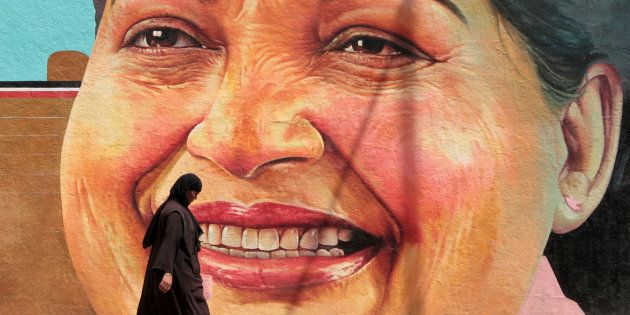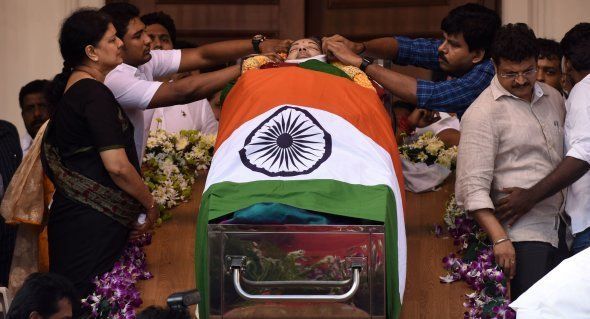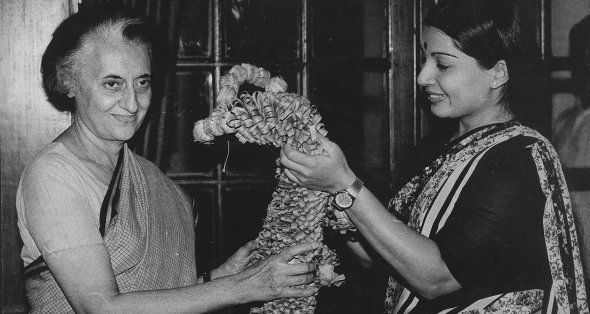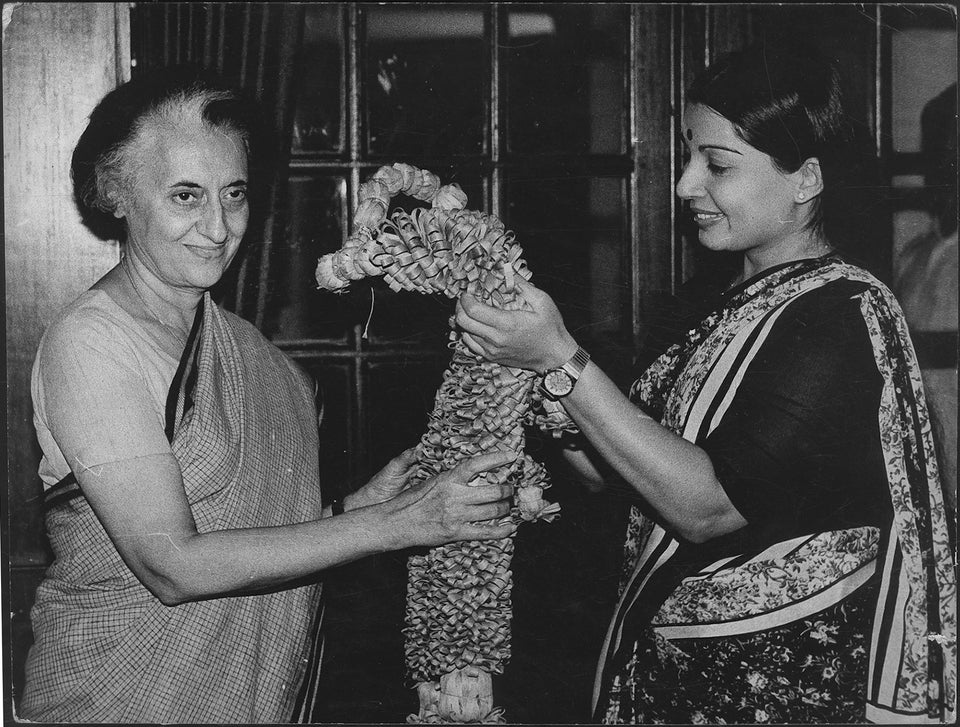
It is hard to imagine any place in the world, where a Muslim man would choose to crucify himself in order to express his love for a Brahmin political leader of a Dravidian party. But Shihan Hussaini, a martial arts expert, did just that to honour Jayalalithaa, the demure actress who transformed into the Iron Lady of Indian politics over the course of three decades.
"I love Madam and whenever we went to her, she had always helped us," Hussaini said of the woman who had used all her strength, intelligence and charm to become a large-than-life figure in a political landscape dominated by men, surpassing even her political mentor M.G. Ramachandran in ambition and vision.
Following a cardiac arrest, the four-time chief minister of Tamil Nadu died on Monday night.
People's Chief Minister
Among the many strands which make up Jayalalithaa's legacy, the defining one is the love which she inspired in millions, a rare feat in times when most people abhor politicians. They celebrated her victories with the pride and joy one feels at the successes of a family member, and they were broken hearted over her troubles. The dark side to this relationship was fanaticism, with people killing themselves over Jayalalithaa. But rather than stomping out such behavior, she and her party, the All India Anna Dravida Munnetra Kazhagam (AIADM), led it feed her aura.
Reflecting on why Jayalalithaa moved people so deeply, A.R. Venkatachalapathy, professor at the Madras Institute of Development Studies, said, "It is a social phenomenon which cannot be rationally explained. There are many politicians who give out freebies but they don't always receive such an emotional investment." Senior journalist R.K. Radhakrishnan, who had interacted with Jayalalithaa over the years, described her as someone who could "charm the hell out of a stone." "She wanted to remain an enigma for the people," he said.

A Lot Of Free Stuff
What set Jayalalithaa up as "Amma" (mother) in the hearts and minds of the people of Tamil Nadu, were the social welfare schemes which she not only promised, but actually delivered on.
Unfazed by those who ridiculed her for handing out freebies in exchange of votes, Jayalalithaa just kept adding to the mind boggling list of items which she made available for free or at a minimal cost. Pre-fixed with the term "Amma," these items included water, baby kits, laptops, cell phones, cement and seeds. Her Amma canteens, where idlis are sold for Rs.1 and sambhar rice and curd rice for Rs. 3, became a Mecca for the poor.
Empowering women
Jayalalithaa revealed her political chops early in her career. When a rival minister of the Dravida Munnetra Kazhagam (DMK) pulled her sari following a fracas in the Tamil Nadu Assembly in 1989, she vowed to return only as the chief minister of the state.
Not only did Jayalalithaa return as the chief minister four times, she came to be looked on as goddess, before whom her party men prostrated themselves. And she used her power to empower other women. Tamil Nadu is now among the states with the lowest infant mortality rate as well as fertility rate in the country. It also has the second highest literacy rate for women--89.8% of women are educated.
In fact, analysis of the 2016 Tamil Nadu election results suggests that women voters brought the AIADMK back to power. While her goddess-like stature triggered the worst-kind of sycophancy from her party men, the sight of men prostrating themselves in front of a woman must have proved cathartic to many women.

Sarees, Shoes And Corruption
In the early nineties, Jayalalithaa epitomized corruption and extravagance. She spent ₹5 crore on the wedding of her foster son Sudhakaran in 1996, amassed some 12,000 saris, and 750 pairs of shoes. BJP leader Subramanian Swamy took her to court over acquiring assets worth ₹66 crore illegally. She was convicted by a trial court in Karnataka in 2014 and sentenced to five years in jail, but she was acquitted by the High Court. The party claimed that the shock of her conviction resulted in the death of more than 200 people.
Observers pointed out that by the time the trial and the verdict had rolled around, Jayalalithaa's Rs66 crore scam had paled before the 2G and CWG scams of 21st century, which ran into hundreds and thousands of crores. But more significantly, Jayalalithaa had managed to change how people saw her--a matronly figure who wore simple saris of blue and green.
Repression
That "perfectly crafted image," according to senior journalist Radhakrishnan, was the result of painstaking media management and repression of journalists. During her first term in the nineties, Radhakrishnan recalled that a photographer was fired from his job because he took a photo of Jayalalithaa wiping the sweat from her face while she was sitting on a stage during a public event.
"She has played victim, goddess, and mother. There has never been one step out of place when it comes to media management," he said.
The Tamil Nadu government filed 213 cases of defamation in the past five years, against people who had dared "malign" their chief minister. But it wasn't just journalists. Jayalalithaa became notorious for crushing dissent, even cracking down on students and labour unions when they dared to cross her.
Her most infamous "iron fist" moment came in 2003, when one lakh government employees and teachers in Tamil Nadu went on strike in 2003 to demand restoration of benefits. She had tens of thousands of employees arrested and 1.7 lakh of them dismissed.

Politics Over LTTE
When the mood turned decisively against the Liberation Tigers of Tamil Eelam (LTTE) following the assassination of Prime Minister Rajiv Gandhi in 991, Jayalalithaa buried the sympathies her party and mentor M.G. Ramachandran had for the group. In September 1992, she wrote to Prime Minister P.V. Narasimha Rao seeking a ban on the LTTE.
In 2002, she used the Prevention of Terrorist Act to arrest several LTTE sympathises including MDMK (Marumalarchi Dravida Munnetra Kazhagam) General Secretary Vaiko for allegedly making pro-LTTE speeches. She also got the state assembly to pass a resolution demanding the extradition of Sri Lanka's Tamil Tiger rebel leader, Velupillai Prabhakaran. When the Sri Lankan army's final campaign against the Tamil Tiger was resulting in the deaths of hundreds of innocent people, she said that civilians dying was inevitable in war.
It was during the final days of the civil war in Sri Lanka, which coincided with the run up to the 2009 Lok Sabha election in India, that she changed her tune. The chief minister knew that public mood had changed in the wake of the atrocities in the Sri Lankan civil war. She urged the Centre to send the army to Sri Lanka to stop the "atrocities" against Tamils. In 2013, the Tamil Nadu assembly passed a resolution demanding a referendum in Sri Lanka for a separate Eelam for Tamils.
"She made cynical use of the public mood. That was her politics all through," said Venkatachalapathy. "She could always use anything to her own advantage. She never stuck to one position."
Ford's "Home Away From Home"
When India opened its economy to the world in the early nineties, Jayalalithaa put Tamil Nadu in the driving seat to usher in change. She opened up her state to foreign investments, which resulted in manufacturers such as Ford and Hyundai setting up shop in Chennai.
After transforming Chennai into the automobile hub in the country, she planned to build it into one of the top five global auto clusters. Announcing a Rs.1,300 crore investment in Chennai, last month, Ford Executive Chairman Bill Ford said, "Chennai is Ford Motor company's home away from home."
Also on HuffPost India
